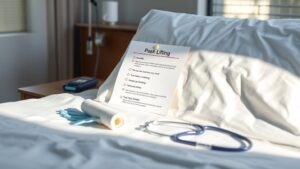After inguinal hernia surgery, recovery feels like walking on a tightrope—every move matters for healing. You’ll need to avoid straining, heavy lifting, or sudden twists to protect the repair. Keeping the incision clean and dry prevents infection, while sticking to light walks boosts circulation without overdoing it. Pain management is key, but so is understanding the moment discomfort signals trouble. With the right balance, you’ll heal faster—but sidestep these guidelines, and setbacks lurk.
Post-Surgery Expectations
After inguinal hernia surgery, your body needs time to heal, and comprehending what to expect can make recovery smoother.
You’ll likely feel soreness around the incision area for 1-2 weeks, but prescribed pain meds and ice packs can help.
Don’t worry should your appetite dip—it’s normal for a week or two as your body focuses on the healing process.
Fatigue is common too, so listen to your body and rest as needed.
You can shower after 36 hours, but avoid baths or pools for two weeks to protect the incision.
Keep an eye on the area—redness, warmth, or pus could signal trouble.
Recovery takes patience, but taking it slow guarantees you heal right.
Stick to light activities and let your body guide you.
Essential Wound Care Practices
Taking care of your incision properly helps you heal faster and lowers the chance of infection.
After hernia surgery, keep the wound dry for the initial 24-48 hours—your primary dressing is usually waterproof. Once you remove it after two days, avoid soaking the area in water for at least a week.
Check the incision daily for redness, swelling, or unusual drainage, and call your doctor should you notice these signs. Steri-strips can get wet but leave them alone until they start peeling (around 7-10 days).
At the time of washing the area, be gentle and skip ointments—let the wound breathe. Good wound care isn’t complicated, but it’s key to infection prevention. Stick to these steps, and you’ll give yourself the best shot at smooth healing.
Activity Restrictions and Movement Guidelines
You’ll need to avoid lifting anything over 15-20 pounds for the initial two weeks to protect your healing incision.
Take short, easy walks to keep your blood flowing, but don’t push yourself—listen to what feels right.
Skip heavy chores, workouts, or climbing ladders for at least 10 days so you don’t strain the area.
Lifting Limits Explained
Because your body needs time to heal, lifting heavy objects too soon after inguinal hernia surgery can set back your recovery—so let’s analyze the limits you should follow.
For the initial two weeks, stick to lifting no more than 10 pounds to protect your hernia repairs from strain. After that, you can slowly increase to 20 pounds by the end of week one and up to 40 pounds by week two, but only in case your surgeon approves.
Avoid strenuous activities like lifting, pushing, or pulling anything heavy for at least 4-6 weeks—your abdominal muscles need this break to heal properly.
Should you be unsure about an activity, ask for help or wait. Following these lifting limits reduces the risk of complications and helps you recover faster.
Listen to your body, and don’t rush it.
Safe Movement Practices
Recovering from inguinal hernia surgery means paying close attention to how you move—even simple actions can strain your healing body.
Stick to safe movement practices by avoiding lifting anything over 10 pounds for at least two weeks. Skip sudden twists, sit-ups, or bending that could pull on your incision. Instead, take short walks to keep blood flowing without overdoing it.
Steer clear of step ladders or stools for 10 days to prevent falls. Listen to your body—if something hurts, stop. Gradually increase activity as you heal, but don’t rush into heavy chores or workouts.
Your surgeon will guide you on whenever to add more movement. Patience now helps prevent setbacks later. Small steps today mean a smoother recovery tomorrow.
Managing Pain and Discomfort
You’ll likely need pain medication for the initial few days after surgery, but you can gradually reduce it as you start feeling better.
Applying ice packs to the area can help ease swelling and soreness, especially in the beginning stages of recovery.
Should your pain feels unmanageable or gets worse, don’t hesitate to call your doctor for advice.
Pain Medication Usage
| Do | Don’t |
|---|---|
| Take meds as prescribed | Skip doses to “tough it out” |
| Track pain levels | Ignore sudden pain spikes |
| Stay hydrated | Overdo activity too soon |
| Use stool softeners when needed | Wait until constipation worsens |
| Call your doctor with concerns | Assume pain is “normal” long-term |
Stick to your plan, and you’ll heal smoother.
Ice Pack Application
Since ice packs can be a simple but effective way to ease discomfort after inguinal hernia surgery, it’s essential to use them correctly.
Apply the ice pack for 15–20 minutes at a time to reduce swelling and numb post-surgery pain. Always wrap it in a cloth to protect your skin—direct contact can cause frostbite.
Repeat every hour for the initial 48 hours, but never exceed 20 minutes per session to avoid irritation. Should swelling linger, space applications further apart after the primary two days.
Listen to your body—should pain persist despite ice pack application, reach out to your doctor.
Keep in mind, consistency matters more than intensity; gentle, frequent cooling works better than long, harsh sessions. Stick to this routine, and you’ll ease recovery smoothly.
Dietary Recommendations for Recovery
After inguinal hernia surgery, what you eat plays a big role in how smoothly your recovery goes. Start with liquids like broth or juice, then ease into small, balanced meals as your stomach settles.
To prevent constipation, focus on fiber-rich foods—think apples, oats, and veggies—aiming for 20-35 grams daily. Stay well-hydrated by sipping water often, about 6-8 cups a day, to help your body heal.
Skip gassy foods like beans or sodas at the beginning to avoid bloating. It’s normal should your appetite dip initially, so listen to your body and choose nutrient-packed bites as hunger returns.
Soft, easy-to-digest options like yogurt or mashed potatoes can be gentle starters. These dietary recommendations keep discomfort low and recovery on track.
Returning to Work and Daily Activities
Though recovery times vary, you’ll likely feel ready to ease back into daily routines within a week or two after inguinal hernia surgery—just don’t rush it.
Start with light activities like short walks or light chores as your body allows, but avoid anything strenuous. Most people can return to work within 1-2 weeks, especially in cases where their job isn’t physically demanding.
Should you have a manual labor job, you may need closer to 4-6 weeks before lifting heavy objects or doing intense tasks.
Listen to your body; should something feel off, slow down. Overdoing it too soon can delay healing or cause complications.
Your recovery period is unique, so don’t compare it to others. Ease back into routines gradually, and prioritize rest when needed.
Monitoring for Potential Complications
Check your incision daily for redness, swelling, or unusual drainage, as these can signal infection.
Pay attention to warning signs like fever, severe pain, or trouble breathing, and don’t ignore them.
Should you notice anything unusual, call your doctor right away—prompt action helps prevent serious complications.
Check Incision Regularly
Since your incision is key to a smooth recovery, keeping an eye on it can help spot potential issues promptly.
Check it daily for redness, warmth, or swelling, which may signal an infection. Look for pus or unusual drainage—these aren’t normal and need quick attention.
Should the area feel harder or more painful than expected, let your doctor know. Some bruising is normal, but excessive discoloration or swelling could mean trouble. Don’t ignore persistent pain that doesn’t improve with meds.
Your healing process depends on catching problems promptly, so stay vigilant. Attend follow-up visits so your surgeon can monitor progress.
Recall, a clean, dry incision heals best—avoid picking at scabs or exposing it to dirt. Small steps now prevent bigger setbacks later.
Recognize Warning Signs
While recovery from inguinal hernia surgery generally goes smoothly, being aware of what warning signs to watch for helps one act fast should something isn’t right.
Check your temperature nightly—should it hit 101°F or stays above 100°F for 24 hours, call your health care provider.
Watch for infection signs like redness, swelling, or pus at the incision.
A sudden bulge or discomfort similar to pre-surgery could mean a hernia recurrence or fluid buildup.
Should you not have a bowel movement within four days, it may signal constipation or a deeper issue.
Severe pain away from the incision, shortness of breath, or numbness in your limbs needs immediate attention.
Spotting these warning signs promptly keeps small problems from turning big.
Report Symptoms Promptly
Grasping what warning signs to look for is only half the battle—acting on them quickly makes all the difference in your recovery.
Should you notice a fever over 101°F (or 100°F after 24 hours), report symptoms promptly to your doctor, as it may signal an infection. Keep an eye on your incision for redness, swelling, or unusual drainage, and don’t hesitate to call your surgeon if things look off.
Sudden pain outside the wound area? Speak up—it could hint at bigger issues.
Constipation is common, but in the event you haven’t had a bowel movement within four days, let your care team know.
Severe shortness of breath, vomiting, or numbness? Seek help immediately.
Trust your gut—should something feel wrong, it’s better to ask than wait. Your health depends on it.
Importance of Follow-Up Appointments
After inguinal hernia surgery, keeping up with follow-up appointments could seem like just another task, but it’s one of the best ways to make sure your recovery stays on track.
These check-ins let your surgeon monitor your healing and spot any issues promptly. You’ll likely have your initial visit 7 to 14 days after your hernia operation to check the incision and possibly remove stitches.
Skipping these appointments could mean missing signs of complications like infection or recurrence. Your doctor can tweak pain management or activity restrictions if necessary, helping you heal faster and safer.
Consider them as your recovery roadmap—they’re how you’ll know at what time it’s okay to ease back into daily life without risking setbacks. Staying consistent gives you peace of mind and the best shot at a smooth recovery.
Clothing and Comfort Considerations
Since the incision area will be sensitive after inguinal hernia surgery, what you wear plays a big role in keeping discomfort to a minimum. Choose loose-fitting clothing made of soft fabrics to avoid irritating the incision. Tight waistbands or rough materials can slow recovery, so opt for breathable, stretchy options that don’t press on the surgical site. Supportive underwear can also help reduce swelling and improve comfort while moving.
Here’s a quick guide to clothing choices during recovery:
| Do’s | Don’ts |
|---|---|
| Loose, breathable tops | Tight jeans or belts |
| Soft, stretchy pants | Rough, scratchy fabrics |
| Supportive underwear | Low-rise or tight briefs |
| Lightweight layers | Heavy, bulky clothing |
| Easy-to-remove clothes | Complicated fasteners |
Prioritize clothing that keeps you comfortable while your body heals.
Long-Term Recovery and Healing Tips
Though inguinal hernia surgery is common, healing fully takes patience—your body needs weeks or even months to recover completely.
Start with light physical activities like short walks to boost circulation and ease stiffness, but avoid heavy lifting or straining for at least 4–6 weeks.
Eat plenty of fiber and drink water to prevent constipation, which can stress your healing area.
Listen to your body—if something hurts, stop and rest. Follow-up with your doctor to track progress and catch any issues promptly.
Wear supportive underwear to reduce discomfort, and ease back into exercise slowly.
Your long-term recovery depends on giving yourself time, so don’t rush.
Small steps now mean fewer setbacks later.





